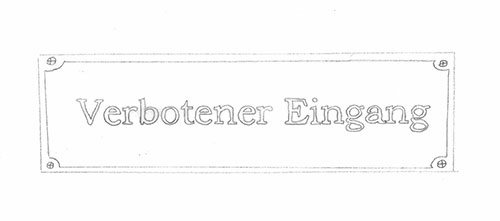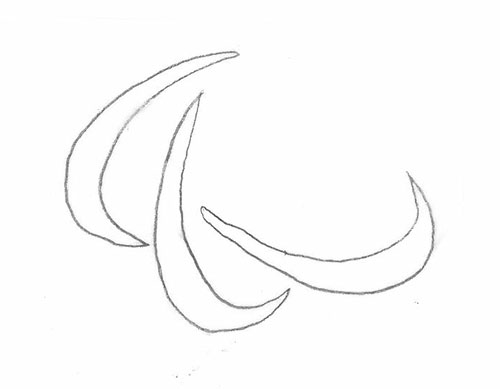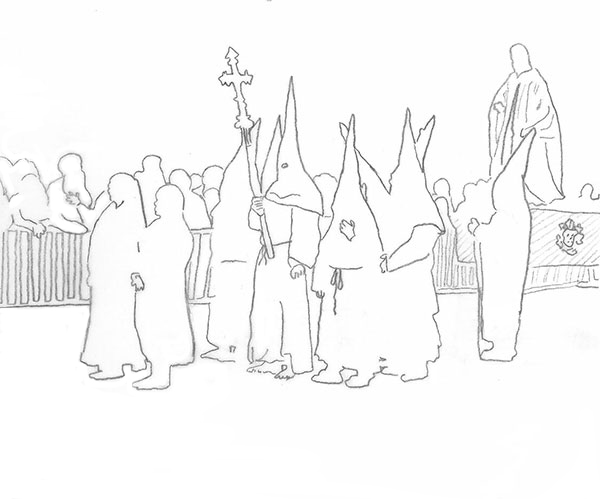Employees of the Jewish Museum Berlin answer the question.
“Leo Scheuer’s prayer capsule. He prayed with it his entire life, even during the 15 months that he spent buried in a hole in the ground hiding from the German occupiers.”
Monika Flores Martínez, Exhibitions
(editor’s note: In her blog post from 22. November 2012 Monika Flores Martínez described what she felt while she worked on the presentation of this object in a display case.)

“My thing of the year is a sign with “Forbidden Entrance” written on it, seen in a Viennese stairwell.”
Kai Gruzdz, Library
“My thing of the year is Macrolon – a fabulous material that’s not only light and easy to work with but that also inspires unlimited creativity!”
Katrin Strube, Collection Management
 “My thing of the year is a medieval ‘Jewish pig’ statue on a church in Bad Wimpfen. It drew attention in the press after the diocese it belongs to produced a replica and placed the original statue in the state museum there, as a cultural heritage piece. It’s an anti-Jewish caricature, and yet, because it’s historical, deserves protection, raising the question: how much public money should be spent on its restoration?
“My thing of the year is a medieval ‘Jewish pig’ statue on a church in Bad Wimpfen. It drew attention in the press after the diocese it belongs to produced a replica and placed the original statue in the state museum there, as a cultural heritage piece. It’s an anti-Jewish caricature, and yet, because it’s historical, deserves protection, raising the question: how much public money should be spent on its restoration?
Naomi Lubrich, Media
Employees of the Jewish Museum Berlin answer the question.
 “My public events of the year were the Olympic and the Paralympic Games in London. (An extra: black-striped cross-eyes the next morning.) There were incomparably more pictures of the Paralympics than ever before: the photos of people sprinting with artificial legs had a particular symbolic power for me: flying over hurdles!”
“My public events of the year were the Olympic and the Paralympic Games in London. (An extra: black-striped cross-eyes the next morning.) There were incomparably more pictures of the Paralympics than ever before: the photos of people sprinting with artificial legs had a particular symbolic power for me: flying over hurdles!”
Ines Rösler, Collections
(editor’s note: Our blog posting for the 31. August 2012 was dedicated to Ludwig Guttmann, father of the Paralympics.)
“For me the discussion about the bestowal of the Adorno Prize on Judith Butler was the event of the year, because the verbal chasm between Butler’s style of argumentation and the colloquial style of the critics who questioned her worthiness to receive the prize deeply dismayed me. A few meals with friends during those late summer weeks threatened to turn into evenings of heated discussion, with all the charm of a plenary assembly for ASTA.”
Mirjam Wenzel, Media
(editor’s note: Four days after the Adorno Prize event, on 15. September 2012, a long-planned panel discussion with Judith  Butler and Micha Brumlik discussed “Does Zionism Belong to Judaism?”)
Butler and Micha Brumlik discussed “Does Zionism Belong to Judaism?”)
“My event of 2012: the Good Friday procession in Perpignan with its bells and drums.”
Johannes Rinke, Visitor Services
The Gregorian calendar, according to which we are now counting the year 2013, begins on circumcisio domini, the day on which Jesus was circumcised. Last year, the act of circumcision was at the center of a political debate which discussed the relationship between non-Jewish Germans, German Jews and Muslims and Jews in Germany. The editors of the Jewish Museum’s website nominate the so-called circumcision debate as the event of the year 2012.
“One event of 2012 is still visible all over the city in 2013: The bancruptcy of the drugstore chain “Schlecker.” Empty store windows on every corner promising better quality of life in the neighborhood. But most will likely end up being storerooms for fitted kitchens.”
Martina Lüdicke, Exhibitions
One task that all of us working at the Jewish Museum share, one that is unwritten, undocumented, and often even unnoticed, is tracking and evaluating Jewish-related discussions and trends. Who is surprised by the Cologne verdict on circumcision? Who is still optimistic about the Arab Spring? Who is tired of all-white “apple design” for everything related to culture, even Jewish culture? Between doorways, at the photocopy machine, at the canteen, these comments unconsciously shape our work, influence our choice of topics and define the museum’s mission. We thought it might be worthwhile to voice some of our opinions and chose a budding literary genre: part lunch conversation, part feuilleton, part diary, part text message. Welcome to the blog of the Jewish Museum Berlin.

 “My thing of the year is a medieval ‘Jewish pig’ statue on a church in Bad Wimpfen. It drew attention in the press after the diocese it belongs to produced a replica and placed the original statue in the state museum there, as a cultural heritage piece. It’s an anti-Jewish caricature, and yet, because it’s historical, deserves protection, raising the question: how much public money should be spent on its restoration?
“My thing of the year is a medieval ‘Jewish pig’ statue on a church in Bad Wimpfen. It drew attention in the press after the diocese it belongs to produced a replica and placed the original statue in the state museum there, as a cultural heritage piece. It’s an anti-Jewish caricature, and yet, because it’s historical, deserves protection, raising the question: how much public money should be spent on its restoration?
